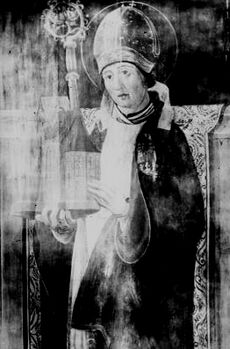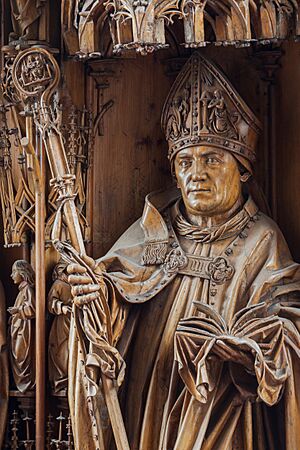Wolfgang of Regensburg facts for kids
Quick facts for kids SaintWolfgang |
|
|---|---|

Saint Wolfgang, stained glass, Parish Church in Leising
|
|
| The Almoner | |
| Born | c. 934 Holy Roman Empire |
| Died | 31 October 994 |
| Venerated in | Catholic Church Eastern Orthodox Church |
| Canonized | 1052 AD by Pope Leo IX |
| Feast | 31 October |
| Attributes | depicted with an axe in the right hand and the crozier in the left; or as a hermit in the wilderness being discovered by a hunter. |
| Patronage | apoplexy; carpenters and wood carvers; paralysis; Regensburg, Germany; stomach diseases; strokes |
Wolfgang of Regensburg (also known as Wolfgangus) was an important religious leader who lived a long time ago. He was born around 934 AD and passed away on October 31, 994 AD. From Christmas 972 until his death, he served as the bishop of Regensburg in Bavaria, a region in what is now Germany.
Wolfgang is considered a saint in both the Catholic Church and the Eastern Orthodox Church. He is seen as one of the three most important German saints of the 10th century. The other two were Ulrich of Augsburg and Conrad of Constance. Towards the end of his life, Wolfgang chose to live as a hermit in a quiet, lonely place in Upper Austria. After he died, many churches chose him as their special patron saint, and several towns were named after him.
Contents
Wolfgang's Early Life and Education
Wolfgang came from a noble family in a region called Swabia. When he was seven years old, a church leader taught him at home. Later, he went to a famous school at Reichenau Abbey, which was a monastery on an island.
Friendships and Learning
At Reichenau, Wolfgang became good friends with Henry of Babenberg. Henry was the brother of Bishop Poppo of Würzburg. Wolfgang followed Henry to Würzburg to attend lectures by a famous Italian scholar named Stephen of Novara. Stephen taught at the cathedral school there.
Working in Trier
In 956, Henry became the Archbishop of Trier. He asked Wolfgang to join him. Wolfgang became a teacher at the cathedral school in Trier. He also worked hard to improve the church in that area. Even though some people didn't like his efforts, he kept going.
Living in Trier greatly influenced Wolfgang. He learned a lot about monastic life and asceticism (a strict, simple way of living). He met Ramuold, a teacher from St. Maximin's Abbey, Trier, a very important monastery at that time. Ramuold later taught Adalbert of Prague, another famous saint.
Becoming a Monk and Priest
After Archbishop Henry of Trier died in 964, Wolfgang decided to join the Benedictine order. He became a monk at the Einsiedeln Abbey in Switzerland. In 968, Saint Ulrich ordained him as a priest.
Wolfgang's Mission to the Magyars
After a big battle in 955 (the Battle of the Lechfeld), the Hungarians settled in a region called Pannonia. They were often a threat to the empire. Bishop Ulrich saw this danger clearly.
Emperor Otto the Great also wanted to help. So, they asked Wolfgang to go and teach the Hungarians about Christianity. The records from the abbey say he was "sent to the Hungarians" because he was the best person for the job. Other missionaries later followed him. They were sent by Piligrim, who was the Bishop of Passau. This new missionary area was under Bishop Piligrim's control.
Wolfgang as Bishop of Regensburg
When Bishop Michael of Regensburg died in 972, Bishop Piligrim asked the emperor to make Wolfgang the new bishop. Wolfgang officially became Bishop of Regensburg on Christmas Day in 972. His work in this new role was very important.
A Royal Teacher
As Bishop of Regensburg, Wolfgang became the teacher of young Henry II. Henry later became a saint and a Holy Roman Emperor. Wolfgang taught him the important values that guided Henry's life. Other important people, like Poppe (who became Archbishop of Trier) and Tagino (who became Archbishop of Magdeburg), also learned from Wolfgang.
Reforming Monasteries
Wolfgang worked hard to improve the rules and discipline in his diocese (his church area). His most important work was at the old and famous St. Emmeram's Abbey. For many years, the bishops of Regensburg had also been in charge of this abbey, which wasn't good for the monks. Wolfgang changed this by giving the abbey its own abbots again. This helped the monks live better and follow their rules more closely.
Wolfgang was one of the first German bishops to do this. Many other bishops later followed his example. He brought a skilled Benedictine monk named Ramuold from Saint Maximin to be the new abbot of Saint Emmeram in 975.
Wolfgang also supported the monastic reforms of Gorze Abbey. These reforms aimed to make sure monks followed the Rule of St. Benedict strictly. He also reformed the convents of Obermünster and Niedermünster in Regensburg. He used the convent of St. Paul, Mittelmünster, which he founded in 983, as an example for them. He also helped reform the old Niederaltaich Abbey, giving it new life.
Serving the Empire
Wolfgang was very generous when Emperor Otto II wanted to make his diocese smaller. This was to create a new Diocese of Prague in 975, with Adalbert of Prague as its first bishop. As a prince of the empire, Wolfgang was very careful to do his duties for the emperor and the empire. Like Saint Ulrich, he was a strong supporter of the emperor's policies.
He attended many imperial meetings called Diets. In 978, he went with Emperor Otto II on a trip to Paris. He also attended a Diet in Verona in 983. After Wolfgang, Gebhard I became the next Bishop of Regensburg.
Wolfgang's Hermitage and Death
In 976, Wolfgang spent a year at Mondsee. This was likely because of a disagreement between Duke Henry II of Bavaria and Emperor Otto II. From Mondsee, he went to live as a hermit in a lonely place. This spot is now known as the Wolfgangsee ("Wolfgang's Lake") in Upper Austria. A hunter eventually found him and brought him back to Regensburg.
While traveling on the Danube River, Wolfgang became ill near the village of Pupping. He asked to be carried into the chapel of Saint Othmar in Pupping, where he passed away.
His friends, Count Aribo of Andechs and Archbishop Hartwich of Salzburg, carried his body back up the Danube to Regensburg. He was buried with great honor in the crypt of Saint Emmeram. Many miracles were reported at his grave. In 1052, he was officially made a saint.
Honoring Saint Wolfgang
Soon after Wolfgang's death, many churches chose him as their special patron saint. Several towns were also named after him.
Wolfgang is sometimes included among the Fourteen Holy Helpers, who are saints believed to help people in certain situations. He is known as the patron saint of woodcutters.
Wolfgang in Art
In Christian art, Wolfgang has been especially honored by the medieval painter Michael Pacher. Pacher created a famous high altar for the church in St. Wolfgang. The paintings from this altar, now in a museum in Munich, show important events from the saint's life. The Kefermarkt altarpiece in Kefermarkt is another large and beautiful artwork dedicated to Saint Wolfgang.
The oldest picture of Wolfgang is a tiny painting from around 1100. It is in a special book called the Evangeliary of Saint Emmeram, which is now in a library in Kraków.
A more modern painting by Moritz von Schwind shows a legend about Wolfgang. In this story, Wolfgang makes the devil help him build a church.
In most paintings, Wolfgang is shown in his bishop's clothes. He usually holds an axe in his right hand and a crozier (a shepherd's crook, a symbol of a bishop) in his left. Sometimes, he is shown as a hermit in the wilderness being found by a hunter.
The axe refers to a story about the saint. After choosing a lonely spot in the wilderness, he prayed and then threw his axe into the trees. He believed that where the axe landed was the place God wanted him to build his small home or cell. This axe is still shown in the small town of St. Wolfgang, which grew up around the spot of his old cell.
Stories About Wolfgang
Around 1050, a Benedictine monk named Otloh of St. Emmeram wrote a book about Wolfgang's life. He did this at the request of St. Emmeram's Abbey. This book is very important for understanding the early history of the church and culture in Bavaria and Austria. It is the main source for all later stories about the saint.
The oldest and best copy of this book is in the library of Einsiedeln Abbey in Switzerland.



